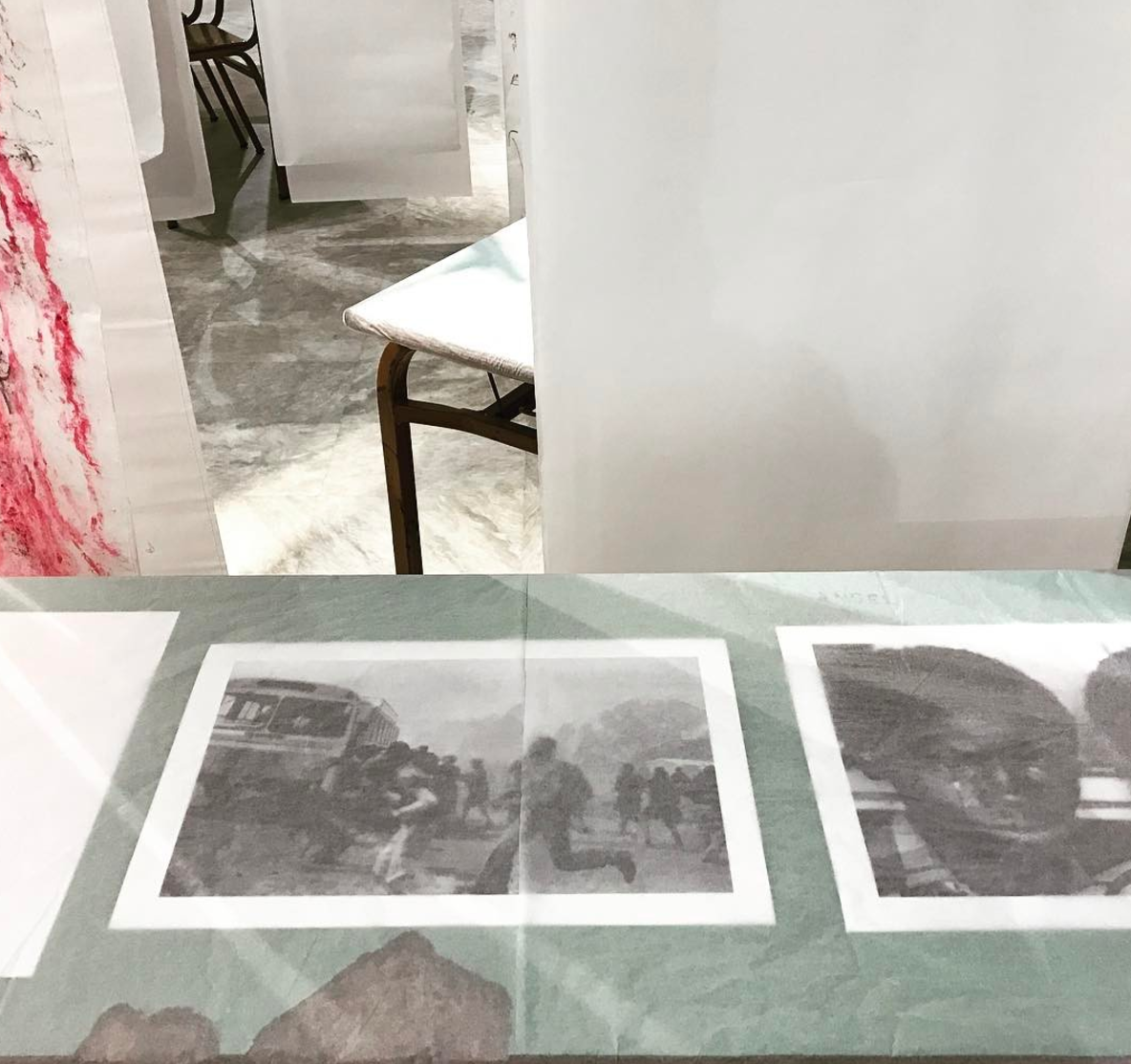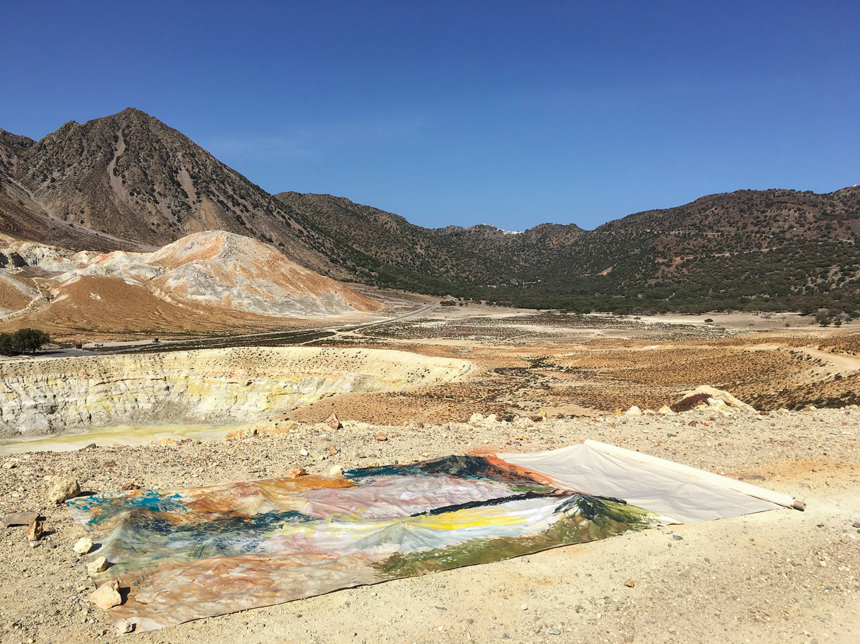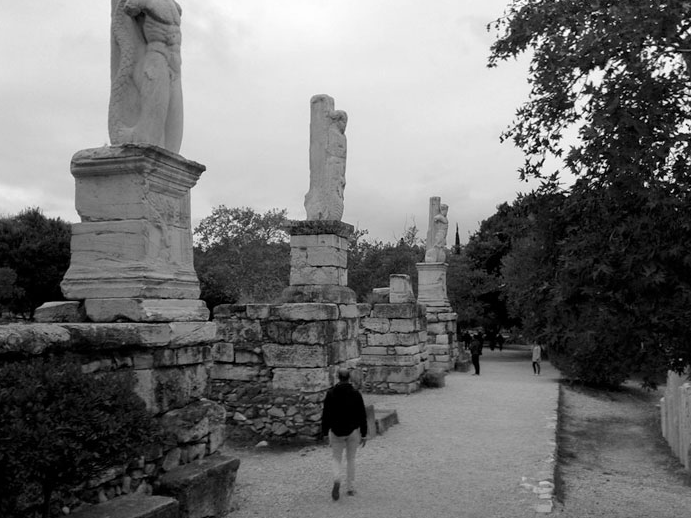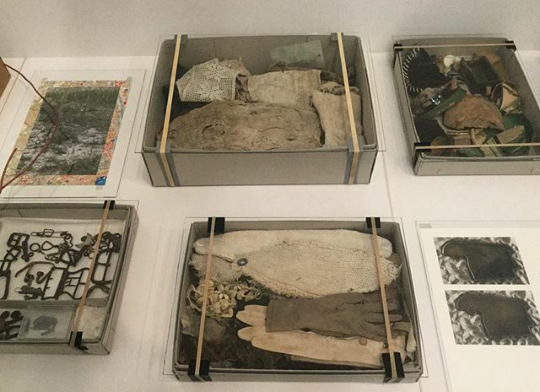THEO ESHETU
Atlas Fractured (2017)
Digital video, color, sound
18 min.
Athens Conservatoire (Odeion), Athens
” At the time of writing, it is not clear how the mask-images from Dahlem will figure in Eshetu’s work for documenta 14, though it is clear that this flattening and thereby masking of the five continents is a point of departure. Pardon the pun—the artist does have a sense of humor in approaching these weighty subjects. Thalia, the Muse of Comedy, has always been a friend. Other friends and casual passersby have been invited to the studio recently. Images—including fragments of the banner—were projected onto their faces and then recorded on video. I wonder what they said about the Stadtschloss, the possibilities of re-presenting, and the communicability of a face. ” Monika Szewczyk.
VIVIAN SUTER
Nisyros (2016)
Oil, volcanic material, earth, botanical matter, and microorganisms on canvas
Seventeen canvases
Dimensions variable
Filopappou Hill, Pikionis Paths and Pavilion, Athens
“Painting is work, and perhaps doubly so in a hot climate, but Vivian has found a way to be fluid within the vicissitudes of terrain and weather. Many of the photos of her work show the paintings in process, some in an airy studio, others outdoors or on a porch; vegetation encroaches and frames nearly all the canvases. Some paintings exhibit traces of hurricanes and floods and are more beautiful for it. For she befriends deluge and mud; she invites time to act on her canvases in the manner of acid biting an etched plate. Implicit in the work is a politics of insistent experimentation and an embrace of ruin.” Moyra Davey
PRINZ GHOLAM
My sweet country (2017) perfomance, at Ancient Agora of Athens-Odeion of Agrippa and at Temple of Olympian Zeus
Central to Athenian democracy and justice was the Agora, a place of assembly for its citizens. At the center of the Ancient Agora of Athens was the Odeion of Agrippa, an auditorium with the capacity to seat one thousand people. It was punctuated by large statues of the Giants and Tritons set on high pedestals, which stand today only as fragments: a torso, a gesture, a symbol. The artists of Prinz Gholam appropriate these ancient forms and write anew their history through orchestrating a movement score between the statues and their own bodies.
LOIS WEINBERGER
Debris Field (2010–16)
Objects excavated from the Weinberger family farmhouse in Austria, photographs, sculptures, and works on paper
Dimensions variable
EMST—National Museum of Contemporary Art, Athens
In Athens, Weinberger’s installation Debris Field presents the “finds” of a further process of excavation; this time the act of sifting through the layers of history, of things accumulated under the floorboards of his parents’ farmhouse in the Austrian Tyrol. The resulting array is a garden of relics assembled from the disorderly remains of centuries of rural life. Like his use of plants, the found objects become the artist’s medium. As he states in the accompanying publication: “I assume the presumptive reasons that underlie an object / to create again a work that exposes and extends the original intentions.” Each item has its own mystery, as if animated by a latent spirit, garnered from “the archaeology of a magically ritualized atmosphere.” Weinberger describes the project as an “ethnology,” and his reflections on the finds, in the form of drawings, objects, notes, photographic works, and in the form of the publication, are integral to the work.
—Tom Trevor
PELAGIE GBAGUIDI The Missing Link. Dicolonisation Education by Mrs Smiling Stone (2017)
The Missing Link. Dicolonisation Education by Mrs Smiling Stone (2017)
School desks, photographs, glassine paper sheets, drawings with colored pencil, microphone stand, earth and lipstick on paper, and digital video
Dimensions variable
Photographs by Dr. Peter Magubane
Athens Conservatoire (Odeion), Athens
“There is no need to try to discuss Pélagie Gbaguidi’s work; it is all perception and senses. Words become useless. Everything is processed through her body beyond reason. Gbaguidi offers us secrets that, in every initiation, are ready to confront. In her art she asks us about ourselves, in the form of a riddle about our origins or about our future. By doing so, she insists on one single but crucial element: that what we have in common, what we have to share and cherish, would be totally in vain if it did not aim to transform us into better beings”.
-Simon Njami
http://www.documenta14.de/en/



